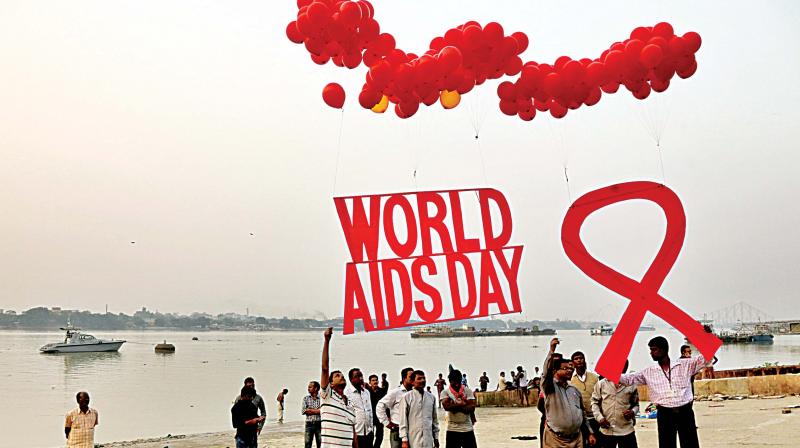HIV Positives, still untouchables...

Bengaluru/Mysuru: “My husband did not support me, neither did my in-laws,” said Padma Kumari (39) who was diagnosed with HIV thirteen years ago. “I had a seven-month old son then and my biggest fear was whether he had contracted HIV through me. I was glad that he was negative,” she said. Padma works as an assistant teacher at a public school in Manjunath Nagar.
Even through AIDS epidemic is more than three decades old, the country is still battling with the stigma attached to HIV patients. “It is difficult to even accept the diagnosis at first,” she said, who had gone to the doctor in connection with a skin ailment. “When we say that we have HIV, people think we probably had sex outside marriage or with multiple partners,” she lamented.
Padma continues to take ART treatment at ASHA Foundation, where one can finding many such women trying a second shot at life. “We need love to build up our confidence in life again,” she summed up. Hers is not an isolated case. There are many battling the stigma and continue to remain reclusive,” she said.
According to the latest report released by the National AIDS Control Organisation (NACO) the total number of people living with HIV (PLHIV) in Karnataka is 1.99 lakhs, the third highest in the country. It is estimated that in 2015 around 13.45 lakhs patients all over the country needed ART, which included 12.71 lakhs adults (15+years) and 75 thousand children. Of this 1.4 lakh PLHIV were from the State. Despite these staggering numbers not much has been done to educate the society.
“The disease may be caused by one bad apple, but the cheated spouse may have to bear the consequences. The stigma is still worse for patients who have got the infection from transfusion of contaminated blood. There are situations where certain hospitals fabricate documents to cover up their lapse,” said Dr Savio Pereira, Medical Director, St John's Hospital. While education and awareness may have led to a decline in the number of HIV cases, but there is little change in the social stigma and the discrimination faced by patients. Hence they avoid reaching out to the community, family, school and workplace, said Dr Glory Alexander, Founder- Director, ASHA Foundation.
Elango, living with HIV for the last 28 years
“HIV-infected can lead a long quality life, provided they change their lifestyle. While the government is providing treatment for HIV infection free of cost, it should also make a provision for the third line of anti retro viral therapy free of cost, treatment of other ailments suffered by the HIV infected and free education to their children. It should start conducting viral load test instead of CD4 count test to know the level of infection free of cost,” said 51-year-old Elango R., who has survived the HIV infection for the last 28 years. He is now on the first line of ART treatment and is leading a quality life.
Elango, co-founder of INP+ -- Indian Network for People Living with HIV and AIDS, and KNP+, is currently serving as a consultant for different hospitals and universities and is conducting training programmes for the HIV-infected groups and health workers on adopting universal precautions in battling HIV infection.
On the secret behind his healthy life, Elango said, “HIV+ve need to have food on time. They should eat healthy and hygienic food. They should ensure they drink at least boiled water. The positives have to go for whole body checkup at least once a year. I do light muscle building exercise and yoga on alternate days.” His wife, 43-year-old Asha Ramaiah, who is also HIV positive for the last 23 years, has been conducting similar training programmes. Their son, for whom they took precautionary measures, is 15 years old now and is HIV free.
ART has made huge difference: Dr. Glory Alexander
So many things have changed in the treatment of HIV/AIDS cases. First and foremost, it has shifted from being a fatal life- threatening illness to a manageable illness and anti- retroviral therapy (ART) has made a huge difference to those living with HIV.
ART has to be taken life long, under the supervision of a doctor, and there has to be more that 95% adherence to medication. Because of this treatment, HIV patients are living much longer and leading better quality of life.
Nowadays, one need not wait till the CD4 count (which asseses the strength of a person’s immune system and serves as guide to HIV treatment choices) reaches a particular value to start ART. The earlier one starts the treatment, the better. Better ART drugs are being produced with lesser side effects. In addition, the starting of two-drug ART in uninfected partners protects them from acquiring HIV infection. This is referred to as PrEP (pre-exposure prophylaxis). Even today research is going on all over the world to find a cure and a vaccine for HIV/AIDS and hopefully this will be a reality in the future.
The writer is director of ASHA Foundation
According to the statistics shared by Karnataka State AIDS Prevention Society, out of 80,000 female sex workers in the State, 6,756 have been tested positive for HIV and only 2,257 are on ART treatment
Keep children safe
Experts say the major focus must to completely eliminate mother-to-child transmissions.“A number of countries have succeeded in completely eliminating this mode of transmission of HIV/AIDS. India must now aim to achieve this feat,” Dr Mahesh, MD, Narayana Hrudayalaya said.
Better blood screening needed
“In India, most blood banks use Elisa (serology) test, which fails to detect infection at an early stage. So, if a person with early stage HIV infection donates blood, there is a risk of Elisa test failing to detect the infection,” said Sumit Bagaria, MD, Indian Foundation for Safe Blood, Bengaluru. Better screening methods need to be followed in hospitals and blood banks to screen donors, he added.

